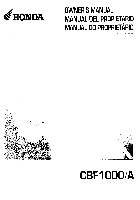На этой странице вы можете совершенно бесплатно скачать Руководство по эксплуатации Honda GXH50.
У документа PDF Руководство по эксплуатации 48 страниц, а его размер составляет 1.84 Mb.
Читать онлайн Двигатели Honda GXH50 Руководство по эксплуатации

Скачать файл PDF «Honda GXH50 Руководство по эксплуатации» (1.84 Mb)
Популярность:
2461 просмотры
Подсчет страниц:
48 страницы
Тип файла:
Размер файла:
1.84 Mb
Прочие инструкции Honda GXH50
Прочие инструкции Honda Двигатели
Прочие инструкции Honda
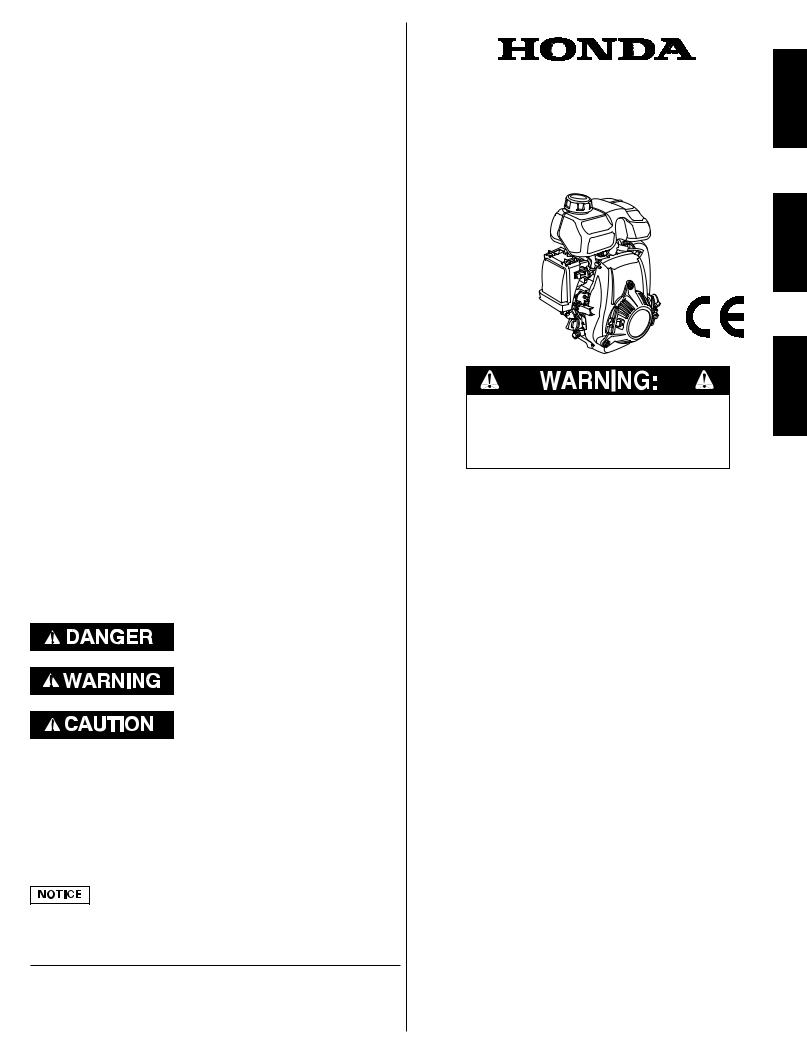
INTRODUCTION
Thank you for purchasing a Honda engine. We want to help you to get the best results from your new engine and to operate it safely. This manual contains information on how to do that; please read it carefully before operating the engine. If a problem should arise, or if you have any questions about your engine, consult an authorized Honda servicing dealer.
All information in this publication is based on the latest product information available at the time of printing. Honda Motor Co., Ltd. reserves the right to make changes at any time without notice and without incurring any obligation. No part of this publication may be reproduced without written permission.
This manual should be considered a permanent part of the engine and should remain with the engine if resold.
Review the instructions provided with the equipment powered by this engine for any additional information regarding engine startup, shutdown, operation, adjustments or any special maintenance instructions.
United States, Puerto Rico, and U.S. Virgin Islands:
We suggest you read the warranty policy to fully understand its coverage and your responsibilities of ownership. The warranty policy is a separate document that should have been given to you by your dealer.
SAFETY MESSAGES
Your safety and the safety of others are very important. We have provided important safety messages in this manual and on the engine. Please read these messages carefully.
A safety message alerts you to potential hazards that could hurt you or others. Each safety message is preceded by a safety alert symbol  and one of three words, DANGER, WARNING, or CAUTION.
and one of three words, DANGER, WARNING, or CAUTION.
These signal words mean:
You WILL be KILLED or SERIOUSLY HURT if you don’t follow instructions.
You CAN be KILLED or SERIOUSLY
HURT if you don’t follow instructions.
You CAN be HURT if you don’t follow instructions.
Each message tells you what the hazard is, what can happen, and what you can do to avoid or reduce injury.
DAMAGE PREVENTION MESSAGES
You will also see other important messages that are preceded by the word NOTICE.
This word means:
Your engine or other property can be damaged if you don’t follow instructions.
The purpose of these messages is to help prevent damage to your engine, other property, or the environment.
 2007 Honda Motor Co., Ltd. All Rights Reserved
2007 Honda Motor Co., Ltd. All Rights Reserved
GXH50U
37Z4C603 00X37-Z4C-6030
|
MANUEL DE L’UTILISATEUR |
ENGLISH |
|
OWNER’S MANUAL |
|
|
MANUAL DEL PROPIETARIO |
|
|
GXH50 |
|
|
FRANÇAIS |
|
The engine exhaust from this product |
ESPAÑOL |
|
contains chemicals known to the State of |
|
|
California to cause cancer, birth defects |
|
|
or other reproductive harm. |
CONTENTS |
|
|
INTRODUCTION…………………… |
1 |
|
SAFETY MESSAGES…………….. |
1 |
|
SAFETY INFORMATION ……….. |
2 |
|
COMPONENT & CONTROL |
|
|
LOCATION …………………………… |
2 |
|
FEATURES…………………………… |
2 |
|
BEFORE OPERATION |
|
|
CHECKS ………………………………. |
3 |
|
OPERATION…………………………. |
3 |
|
SAFE OPERATING |
|
|
PRECAUTIONS …………………. |
3 |
|
STARTING THE ENGINE ……. |
3 |
|
SETTING ENGINE SPEED…… |
4 |
|
STOPPING THE ENGINE ……. |
5 |
|
SERVICING YOUR ENGINE …… |
6 |
|
THE IMPORTANCE OF |
|
|
MAINTENANCE ………………… |
6 |
|
MAINTENANCE SAFETY……. |
6 |
|
SAFETY PRECAUTIONS…….. |
6 |
|
MAINTENANCE |
|
|
SCHEDULE……………………….. |
6 |
|
REFUELING………………………. |
7 |
|
ENGINE OIL………………………. |
7 |
|
Recommended Oil …………. |
7 |
|
Oil Level Check………………. |
8 |
|
Oil Change…………………….. |
8 |
|
AIR CLEANER……………………. |
9 |
|
Inspection……………………… |
9 |
|
Cleaning ……………………….. |
9 |
|
SPARK PLUG …………………… |
.9 |
|
SPARK ARRESTER ………….. |
10 |
|
HELPFUL TIPS & |
|
|
SUGGESTIONS ………………….. |
10 |
|
STORING YOUR ENGINE…. |
10 |
|
TRANSPORTING …………….. |
12 |
|
TAKING CARE OF |
|
|
UNEXPECTED PROBLEMS ….. |
12 |
|
TECHNICAL INFORMATION… |
13 |
|
Serial Number Location …… |
13 |
|
Carburetor Modifications for |
|
|
High Altitude Operation …… |
13 |
|
Emission Control System |
|
|
Information …………………….. |
14 |
|
Air Index…………………………. |
14 |
|
Specifications …………………. |
15 |
|
Tuneup Specifications……… |
15 |
|
Quick Reference |
|
|
Information …………………….. |
15 |
|
Wiring Diagrams …………….. |
15 |
|
CONSUMER INFORMATION..16 |
|
|
Distributor/Dealer Locator |
|
|
Information …………………….. |
16 |
|
Customer Service |
|
|
Information …………………….. |
16 |
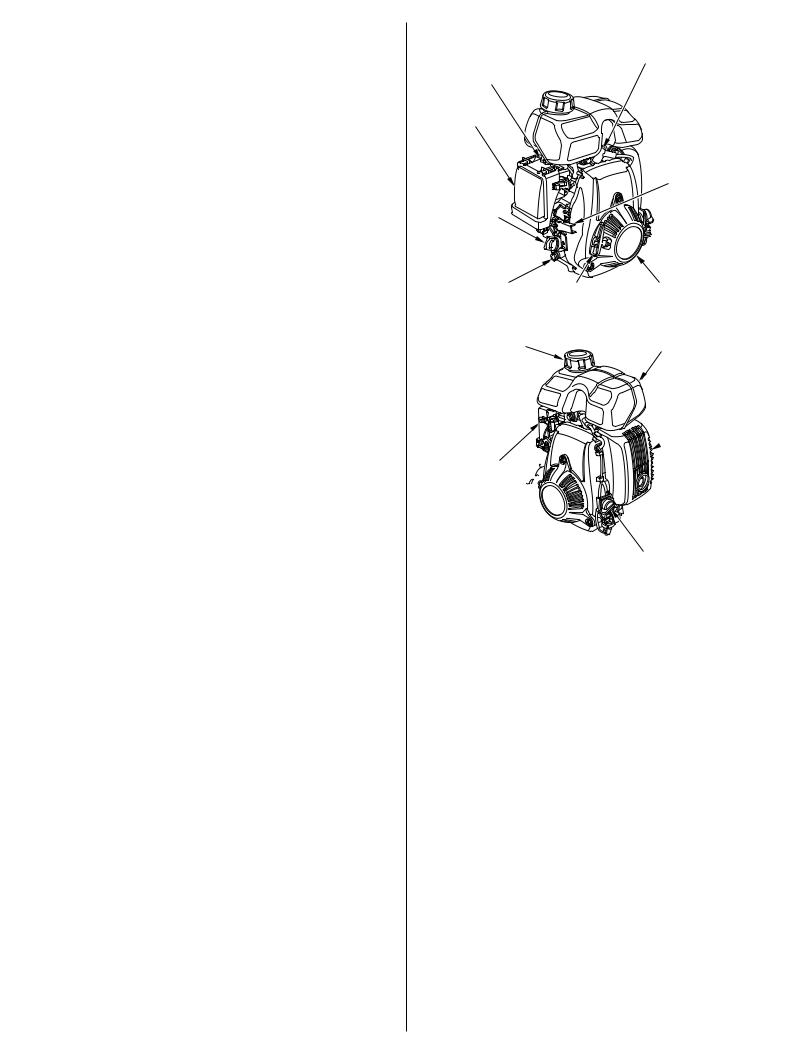
SAFETY INFORMATION
 Understand the operation of all controls and learn how to stop the engine quickly in case of emergency. Make sure the operator receives adequate instruction before operating the equipment.
Understand the operation of all controls and learn how to stop the engine quickly in case of emergency. Make sure the operator receives adequate instruction before operating the equipment.
 Do not allow children to operate the engine. Keep children and pets away from the area of operation.
Do not allow children to operate the engine. Keep children and pets away from the area of operation.
 Your engine’s exhaust contains poisonous carbon monoxide. Do not run the engine without adequate ventilation, and never run the engine indoors.
Your engine’s exhaust contains poisonous carbon monoxide. Do not run the engine without adequate ventilation, and never run the engine indoors.
 The engine and exhaust become very hot during operation. Keep the engine at least 1 meter (3 feet) away from buildings and other equipment during operation. Keep flammable materials away, and do not place anything on the engine while it is running.
The engine and exhaust become very hot during operation. Keep the engine at least 1 meter (3 feet) away from buildings and other equipment during operation. Keep flammable materials away, and do not place anything on the engine while it is running.
COMPONENT & CONTROL LOCATION
SPARK PLUG
CHOKE LEVER
AIR CLEANER
THROTTLE LEVER
OIL FILLER CAP/
DIPSTICK
|
OIL DRAIN PLUG |
STARTER GRIP |
RECOIL STARTER |
|
FUEL FILLER CAP |
FUEL TANK |
 MUFFLER
MUFFLER
FUEL VALVE LEVER 
ENGINE SWITCH
FEATURES
Oil Alert System (applicable types)
System (applicable types)
‘‘Oil Alert is a registered trademark in the United States’’
System 1 (applicable types)
The Oil Alert system is designed to prevent engine damage caused by an insufficient amount of oil in the crankcase. Before the oil level in the crankcase can fall below a safe limit, the Oil Alert system will automatically stop the engine (the engine switch will remain in the ON position).
If the engine stops and will not restart, check the engine oil level (see page 8 ) before troubleshooting in other areas.
System 2 (applicable types)
The Oil Alert system is designed to prevent engine damage caused by an insufficient amount of oil in the crankcase. Before the oil level in the crankcase can fall below a safe limit, the Oil Alert system will prevent the engine from starting.
If the engine will not start, check the engine oil level (see page 8 ) before troubleshooting in other areas.

BEFORE OPERATION CHECKS
IS YOUR ENGINE READY TO GO?
For your safety, and to maximize the service life of your equipment, it is very important to take a few moments before you operate the engine to check its condition. Be sure to take care of any problem you find, or have your servicing dealer correct it, before you operate the engine.
Improperly maintaining this engine, or failure to correct a problem before operation, can cause a malfunction in which you can be seriously hurt or killed.
Always perform a pre-operation inspection before each operation, and correct any problem.
Before beginning your pre-operation checks, be sure the engine is level and the engine switch is in the OFF position.
Always check the following items before you start the engine:
Check the General Condition of the Engine
1.Look around and underneath the engine for signs of oil or gasoline leaks.
2.Remove any excessive dirt or debris, especially around the muffler and recoil starter.
3.Look for signs of damage.
4.Check that all shields and covers are in place, and all nuts, bolts, and screws are tightened.
Check the Engine
1.Check the fuel level (see page 7 ). Starting with a full tank will help to eliminate or reduce operating interruptions for refueling.
2.Check the engine oil level (see page 8 ). Running the engine with a low oil level can cause engine damage.
The Oil Alert system (applicable types) will automatically stop the engine before the oil level falls below safe limits. However, to avoid the inconvenience of an unexpected shutdown, always check the engine oil level before startup.
3.Check the air filter element (see page 9 ). A dirty air filter element will restrict air flow to the carburetor, reducing engine performance.
4.Check the equipment powered by this engine.
Review the instructions provided with the equipment powered by this engine for any precautions and procedures that should be followed before engine startup.
OPERATION
SAFE OPERATING PRECAUTIONS
Before operating the engine for the first time, please review the
SAFETY INFORMATION section on page 2 and the BEFORE OPERATION CHECKS on this page.
Carbon monoxide gas is toxic. Breathing it can cause unconsciousness and even kill you.
Avoid any areas or actions that expose you to carbon monoxide.
Review the instructions provided with the equipment powered by this engine for any safety precautions that should be observed with engine startup, shutdown or operation.
STARTING THE ENGINE
1. Move the fuel valve lever to the ON position.
FUEL VALVE LEVER
ON
ON
2.To start a cold engine, move the choke lever to the CLOSED position.
CHOKE LEVER
CLOSED
To restart a warm engine, leave the choke lever in the OPEN position.
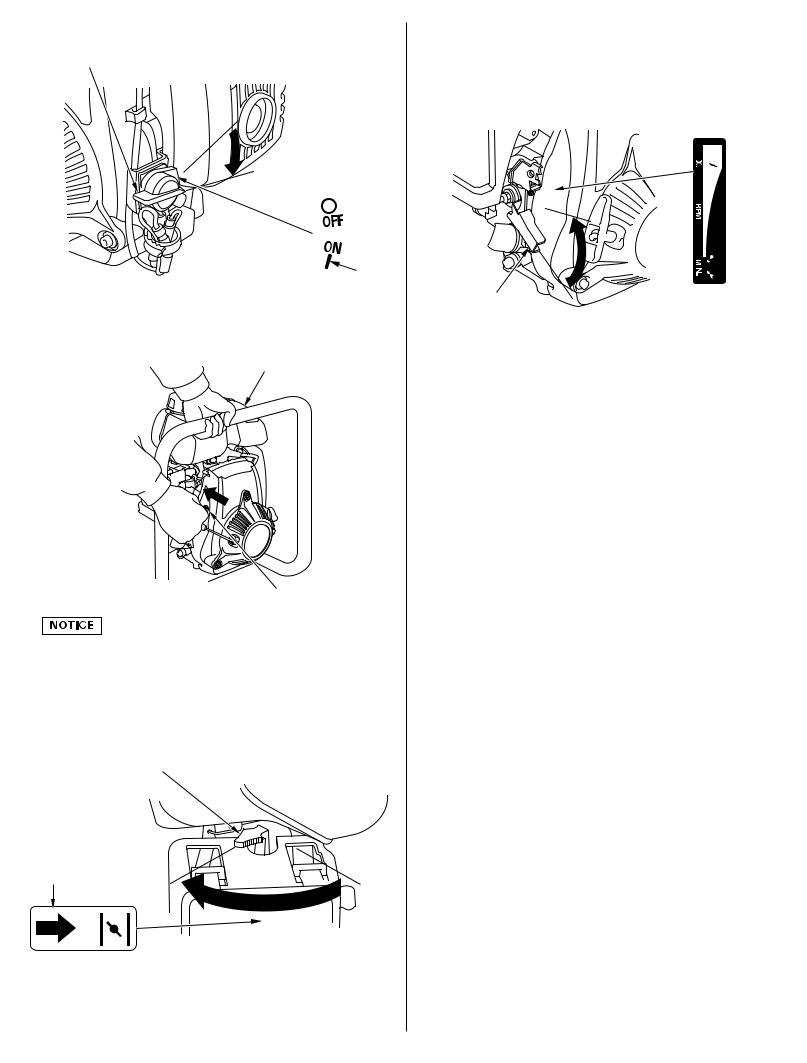
3.Turn the engine switch to the ON position.
ENGINE SWITCH
ON
 ON
ON
4.Pull the starter grip lightly until you feel resistance, then pull briskly. Return the starter grip gently.
(EQUIPMENT SIDE)
STARTER GRIP
Do not allow the starter grip to snap back against the engine. Return it gently to prevent damage to the starter.
5.If the choke lever has been moved to the CLOSED position to start the engine, gradually move it to the OPEN position as the engine warms up.
CHOKE LEVER
OPEN
SETTING ENGINE SPEED
Position the throttle lever for the desired engine speed.
For engine speed recommendations, refer to the instructions provided with the equipment powered by this engine.


 MAX.
MAX.
MAX.


 MIN.
MIN.

STOPPING THE ENGINE
To stop the engine in an emergency, simply turn the engine switch to the OFF position. Under normal conditions, use the following procedure.
1. Move the throttle lever to the MIN. position.


 MIN.
MIN.
THROTTLE LEVER
MIN.
2. Turn the engine switch to the OFF position.
ENGINE SWITCH
OFF
 OFF
OFF
3. Turn the fuel valve lever to the OFF position.
OFF
OFF
FUEL VALVE
LEVER

SERVICING YOUR ENGINE
THE IMPORTANCE OF MAINTENANCE
Good maintenance is essential for safe, economical and troublefree operation. It will also help reduce pollution.
Improper maintenance, or failure to correct a problem before operation, can cause a malfunction in which you can be seriously hurt or killed.
Always follow the inspection and maintenance recommendations and schedules in this owner’s manual.
To help you properly care for your engine, the following pages include a maintenance schedule, routine inspection procedures, and simple maintenance procedures using basic hand tools. Other service tasks that are more difficult, or require special tools, are best handled by professionals and are normally performed by a Honda technician or other qualified mechanic.
The maintenance schedule applies to normal operating conditions. If you operate your engine under severe conditions, such as sustained high-load or high-temperature operation, or use in unusually wet or dusty conditions, consult your servicing dealer for recommendations applicable to your individual needs and use.
Maintenance, replacement, or repair of the emission control devices and systems may be performed by any engine repair establishment or individual, using parts that are ‘‘certified’’ to EPA standards.
MAINTENANCE SAFETY
Some of the most important safety precautions follow. However, we cannot warn you of every conceivable hazard that can arise in performing maintenance. Only you can decide whether or not you should perform a given task.
Failure to properly follow maintenance instructions and precautions can cause you to be seriously hurt or killed.
Always follow the procedures and precautions in this owner’s manual.
SAFETY PRECAUTIONS
 Make sure the engine is off before you begin any maintenance or repairs. This will eliminate several potential hazards:
Make sure the engine is off before you begin any maintenance or repairs. This will eliminate several potential hazards:
Carbon monoxide poisoning from engine exhaust.
Operate outside away from open windows or doors.
Burns from hot parts.
Let the engine and exhaust system cool before touching.
Injury from moving parts.
Do not run the engine unless instructed to do so.
 Read the instructions before you begin, and make sure you have the tools and skills required.
Read the instructions before you begin, and make sure you have the tools and skills required.
 To reduce the possibility of fire or explosion, be careful when working around gasoline. Use only a non-flammable solvent, not gasoline, to clean parts. Keep cigarettes, sparks and flames away from all fuel related parts.
To reduce the possibility of fire or explosion, be careful when working around gasoline. Use only a non-flammable solvent, not gasoline, to clean parts. Keep cigarettes, sparks and flames away from all fuel related parts.
Remember that an authorized Honda servicing dealer knows your engine best and is fully equipped to maintain and repair it.
To ensure the best quality and reliability, use only new genuine Honda parts or their equivalents for repair and replacement.
MAINTENANCE SCHEDULE
|
REGULAR SERVICE PERIOD (1) |
Each |
First |
Every 3 |
Every 6 |
Every |
Every 2 |
Refer |
|||
|
Perform at every indicated month |
use |
month |
months |
months |
year |
years |
to |
|||
|
or operating hour interval, |
or |
or |
or |
or |
or |
page |
||||
|
whichever comes first. |
10 hrs. |
25 hrs. |
50 hrs. |
100 hrs. |
300 hrs. |
|||||
|
ITEM |
||||||||||
|
Engine oil |
Check level |
8 |
||||||||
|
Change |
(3) |
|||||||||
|
Air filter |
Check |
9 |
||||||||
|
Clean |
(2) |
|||||||||
|
Spark plug |
Check-adjust |
9 |
||||||||
|
Replace |
||||||||||
|
Spark arrester |
Clean |
10 |
||||||||
|
(applicable types) |
||||||||||
|
Fuel tank and |
Clean |
(4) |
||||||||
|
filter |
||||||||||
|
Idle speed |
Check-adjust |
(4) |
||||||||
|
Valve clearance |
Check-adjust |
(4) |
||||||||
|
Combustion chamber |
Clean |
After every 300 hrs. (4) |
||||||||
|
Fuel tube |
Check |
Every 2 years (Replace if necessary) (4) |
See shop manual.
(1)For commercial use, log hours of operation to determine proper maintenance intervals.
(2)Service more frequently when used in dusty areas.
(3)Change engine oil every 25 hours when used under heavy load or in high ambient temperatures.
(4)These items should be serviced by your Honda servicing dealer, unless you have the proper tools and are mechanically proficient. Refer to the Honda shop manual for service procedures.
Failure to follow this maintenance schedule could result in nonwarrantable failures.
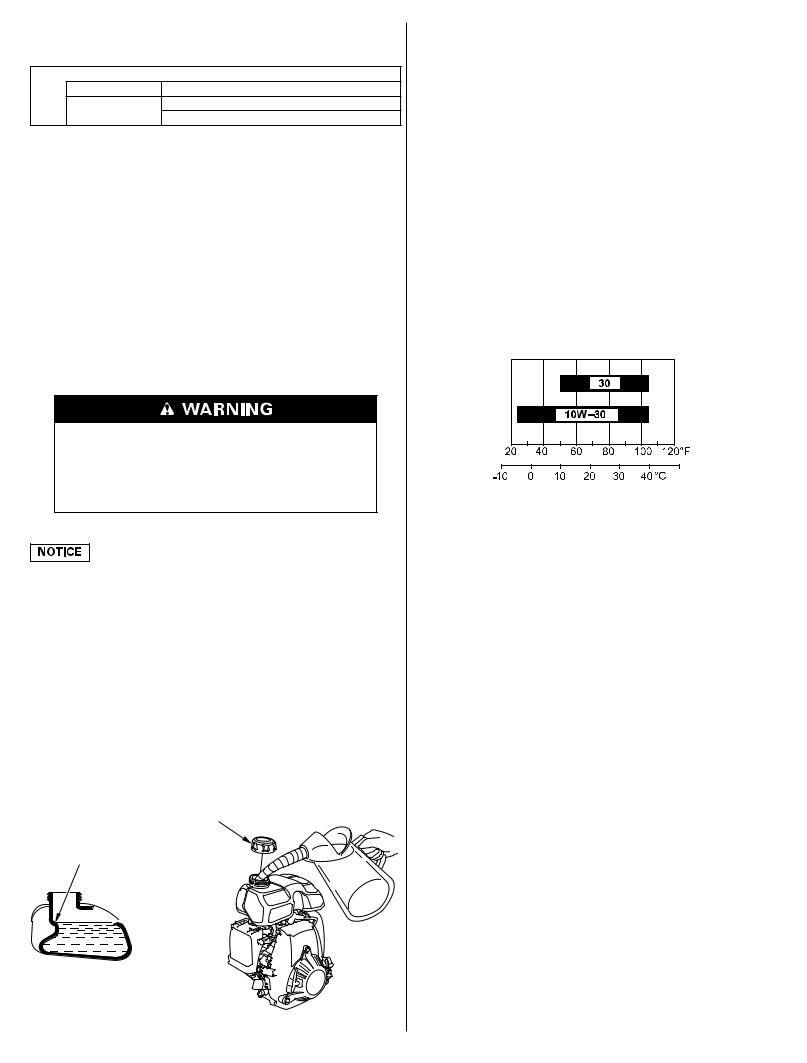
REFUELING
Recommended Fuel
Unleaded gasoline
|
U.S. |
Pump octane rating 86 or higher |
|
Except U.S. |
Research octane rating 91 or higher |
|
Pump octane rating 86 or higher |
This engine is certified to operate on unleaded gasoline with a pump octane rating of 86 or higher (a research octane rating of 91 or higher).
Refuel in a well-ventilated area with the engine stopped. If the engine has been running, allow it to cool first. Never refuel the engine inside a building where gasoline fumes may reach flames or sparks.
You may use regular unleaded gasoline containing no more than 10% Ethanol (E10) or 5% Methanol by volume. In addition, Methanol must contain cosolvents and corrosion inhibitors. Use of fuels with content of Ethanol or Methanol greater than shown above may cause starting and/or performance problems. It may also damage metal, rubber, and plastic parts of the fuel system. Engine damage or performance problems that result from using a fuel with percentages of Ethanol or Methanol greater than shown above are not covered under warranty.
Gasoline is highly flammable and explosive, and you can be burned or seriously injured when refueling.
 Stop engine and keep heat, sparks, and flame away.
Stop engine and keep heat, sparks, and flame away.
 Refuel only outdoors.
Refuel only outdoors.  Wipe up spills immediately.
Wipe up spills immediately.
Fuel can damage paint and some types of plastic. Be careful not to spill fuel when filling your fuel tank. Damage caused by spilled fuel is not covered under the Distributor’s Limited Warranty.
Never use stale or contaminated gasoline or oil/gasoline mixture. Avoid getting dirt or water in the fuel tank.
Move at least 1 meter (3 feet) away from the fueling source and site before starting the engine.
1.With the engine stopped and on a level surface, remove the fuel filler cap and check the fuel level. Refill the tank if the fuel level is low.
2.Add fuel to the bottom of the fuel level mark of the fuel tank. Do not overfill. Wipe up spilled fuel before starting the engine.
FUEL FILLER CAP
FUEL LEVEL
MARK

 MAXIMUM
MAXIMUM
FUEL LEVEL
3.Refuel carefully to avoid spilling fuel. Do not fill the fuel tank completely. It may be necessary to lower the fuel level depending on operating conditions. After refueling, tighten the fuel filler cap securely.
Keep gasoline away from appliance pilot lights, barbecues, electric appliances, power tools, etc.
Spilled fuel is not only a fire hazard, it causes environmental damage. Wipe up spills immediately.
ENGINE OIL
Oil is a major factor affecting performance and service life. Use 4-stroke automotive detergent oil.
Recommended Oil
Use 4-stroke motor oil that meets or exceeds the requirements for API service category SJ or later (or equivalent). Always check the API service label on the oil container to be sure it includes the letters SJ or later (or equivalent).
AMBIENT TEMPERATURE
SAE 10W-30 is recommended for general use. Other viscosities shown in the chart may be used when the average temperature in your area is within the indicated range.
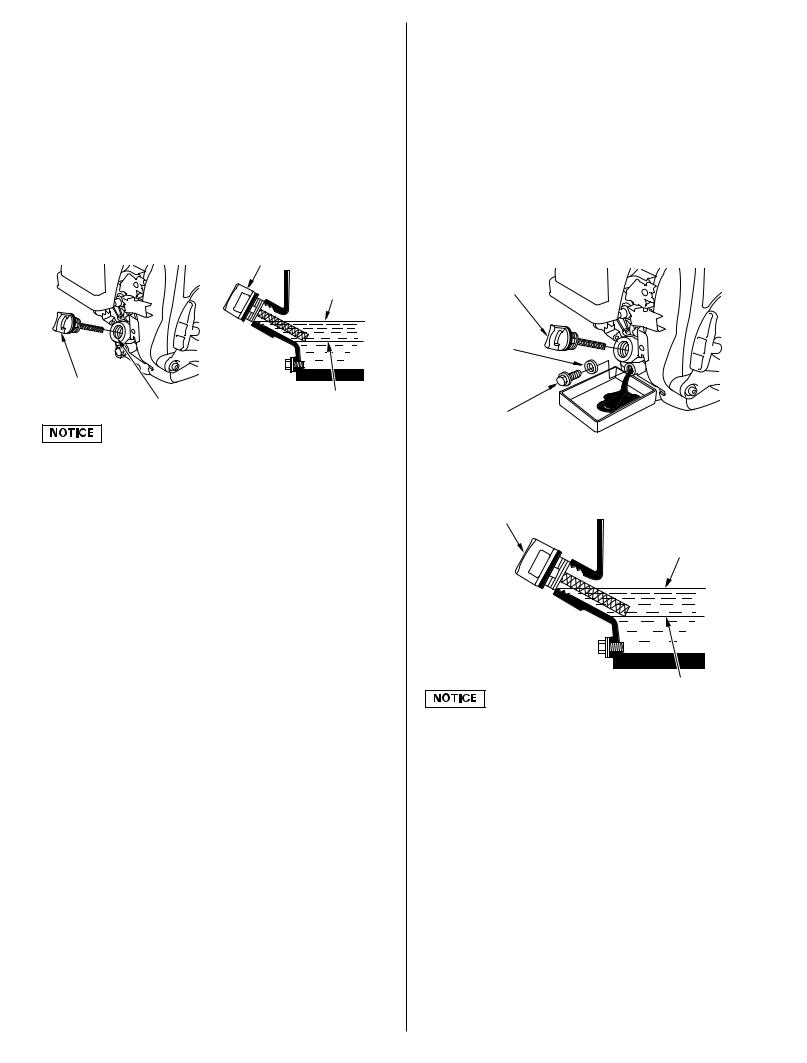
Oil Level Check
Check the engine oil level with the engine stopped and in a level position.
1.Remove the oil filler cap/dipstick and wipe it clean.
2.Insert the oil filler cap/dipstick into the oil filler neck as shown, but do not screw it in, then remove it to check the oil level.
3.If the oil level is near or below the lower limit mark on the dipstick, fill with the recommended oil (see page 7 ) to the upper limit mark (bottom edge of the oil fill hole). Do not overfill.
4.Reinstall the oil filler cap/dipstick.
OIL FILLER CAP/DIPSTICK
UPPER LIMIT
|
OIL FILLER CAP/ |
||
|
DIPSTICK |
OIL FILL HOLE |
LOWER LIMIT |
|
(bottom edge) |
Running the engine with a low oil level can cause engine damage. This type of damage is not covered by the Distributor’s Limited Warranty.
The Oil Alert system (applicable types) will automatically stop the engine before the oil level falls below the safe limit. However, to avoid the inconvenience of an unexpected shutdown, always check the engine oil level before startup.
Oil Change
Drain the used oil when the engine is warm. Warm oil drains quickly and completely.
1.Place a suitable container below the engine to catch the used oil, then remove the oil filler cap/dipstick, oil drain plug and washer.
2.Allow the used oil to drain completely, then reinstall the oil drain plug and new washer, and tighten the oil drain plug securely.
Please dispose of used motor oil in a manner that is compatible with the environment. We suggest you take used oil in a sealed container to your local recycling center or service station for reclamation. Do not throw it in the trash, pour it on the ground, or pour it down a drain.
OIL FILLER CAP/
DIPSTICK
SEALING
WASHER
OIL DRAIN PLUG
3.With the engine in a level position, fill with the recommended oil (see page 7 ) to the upper limit mark (bottom edge of the oil fill hole).
OIL FILLER CAP/DIPSTICK
UPPER LIMIT
LOWER LIMIT
Running the engine with a low oil level can cause engine damage. This type of damage is not covered by the Distributor’s Limited Warranty.
The Oil Alert system (applicable types) will automatically stop the engine before the oil level falls below the safe limit. However, to avoid the inconvenience of an unexpected shutdown, fill to the upper limit, and check the oil level regularly.
4. Reinstall the oil filler cap/dipstick securely.
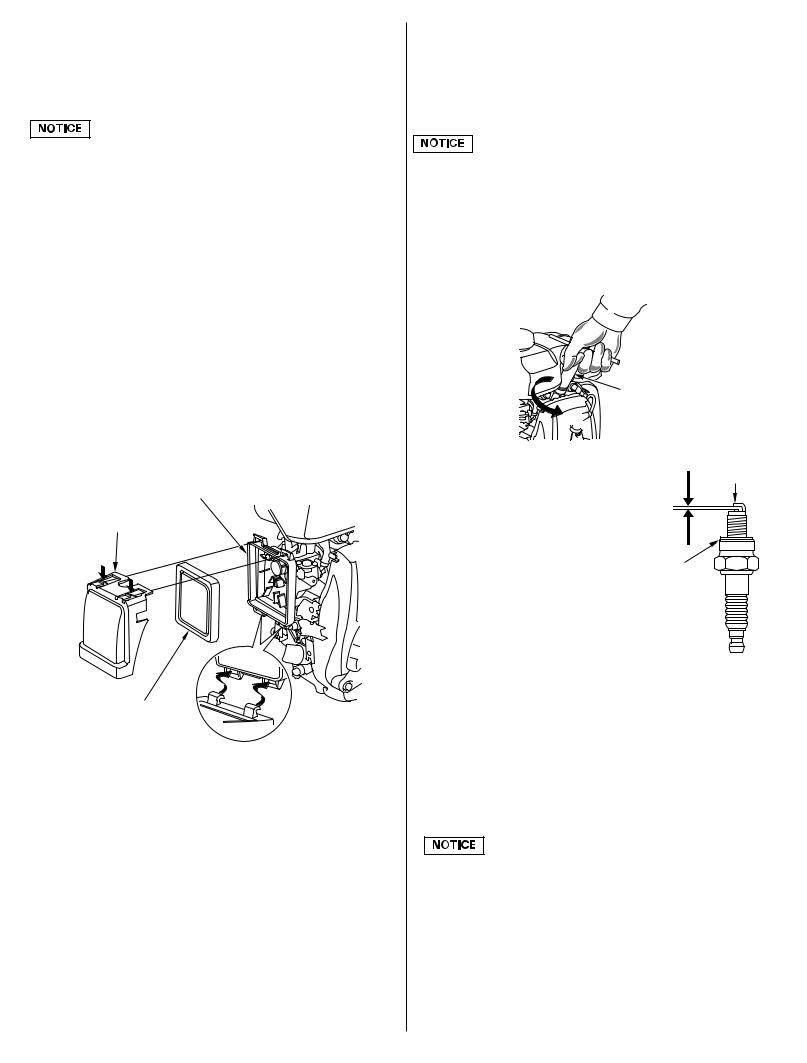
AIR CLEANER
A dirty air cleaner will restrict air flow to the carburetor, reducing engine performance. If you operate the engine in very dusty areas, clean the air filter more often than specified in the MAINTENANCE SCHEDULE.
Operating the engine without an air filter, or with a damaged air filter, will allow dirt to enter the engine, causing rapid engine wear. This type of damage is not covered by the Distributor’s Limited Warranty.
Inspection
Remove the air cleaner cover and inspect the filter element. Clean or replace a dirty filter element. Always replace a damaged filter element.
Cleaning
1.Clean the filter element in warm soapy water, rinse, and allow to dry thoroughly. Or clean in non-flammable solvent and allow to dry.
2.Dip the filter element in clean engine oil, then squeeze out all excess oil. The engine will smoke when started if too much oil is left in the element.
3.Wipe dirt from the air cleaner body and cover, using a moist rag. Be careful to prevent dirt from entering the carburetor.
AIR CLEANER BODY
AIR CLEANER COVER
FILTER
ELEMENT
SPARK PLUG
Recommended Spark Plugs: CR5HSB (NGK)
U16FSR-UB (DENSO)
The recommended spark plug has the correct heat range for normal engine operating temperatures.
An incorrect spark plug can cause engine damage.
For good performance, the spark plug must be properly gapped and free of deposits.
1.Disconnect the spark plug cap, and remove any dirt from around the spark plug area.
2.Remove the spark plug with a 5/8-inch spark plug wrench.
SPARK PLUG WRENCH

 SPARK PLUG CAP
SPARK PLUG CAP
3. Inspect the spark plug. Replace it if damaged or badly fouled, if the sealing washer is in poor condition,
|
or if the electrode is worn. |
0.60 0.70 mm |
|
|
(0.024 0.028 in) |
||
|
4. Measure the spark plug |
||
|
electrode gap with a wire- |
SEALING |
|
|
type feeler gauge. Correct the |
WASHER
gap, if necessary, by carefully bending the side electrode. The gap should be:
0.60 0.70 mm (0.024 0.028 in)
5. Install the spark plug carefully, by hand, to avoid crossthreading.
SIDE ELECTRODE
6.After the spark plug is seated, tighten with a 5/8-inch spark plug wrench to compress the sealing washer.
7.When installing a new spark plug, tighten 1/2 turn after the spark plug seats to compress the washer.
8.When reinstalling the original spark plug, tighten 1/8 1/4 turn after the spark plug seats to compress the washer.
A loose spark plug can overheat and damage the engine. Overtightening the spark plug can damage the threads in the cylinder head.
9.Attach the spark plug cap to the spark plug.
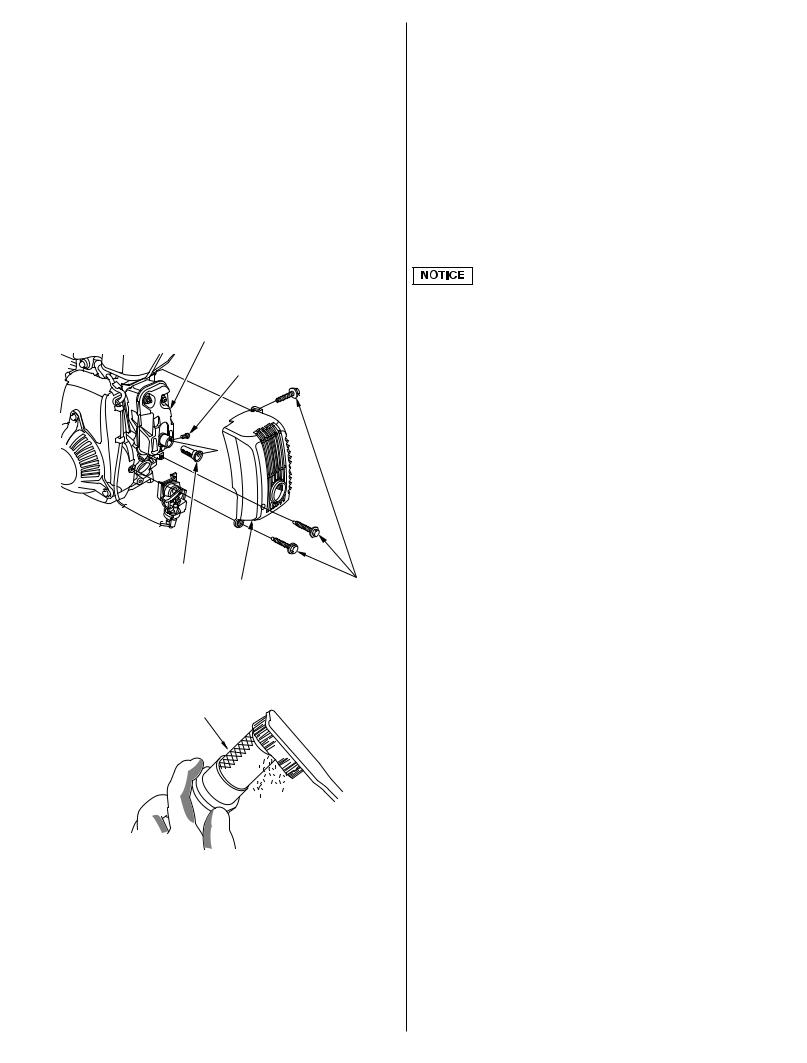
SPARK ARRESTER (optional equipment)
Your engine is not factory-equipped with a spark arrester. In some areas, it is illegal to operate an engine without a spark arrester. Check local laws and regulations. A spark arrester is available from authorized Honda servicing dealers.
The spark arrester must be serviced every 100 hours to keep it functioning as designed.
If the engine has been running, the muffler will be hot. Allow it to cool before servicing the spark arrester.
Spark Arrester Removal
1.Remove the three 5 mm bolts from the muffler protector and remove the muffler protector.
2.Remove the special screw from the spark arrester, and remove the spark arrester from the muffler.
MUFFLER
SPECIAL SCREW
SPARK ARRESTER
MUFFLER PROTECTOR 5 mm
BOLTS
Spark Arrester Cleaning & Inspection
1.Use a brush to remove carbon deposits from the spark arrester screen. Be careful not to damage the screen. Replace the spark arrester if it has breaks or holes.
SPARK ARRESTER SCREEN
2.Install the spark arrester and muffler protector in the reverse order of disassembly.
HELPFUL TIPS & SUGGESTIONS
STORING YOUR ENGINE
Storage Preparation
Proper storage preparation is essential for keeping your engine trouble-free and looking good. The following steps will help to keep rust and corrosion from impairing your engine’s function and appearance, and will make the engine easier to start when you use it again.
Cleaning
If the engine has been running, allow it to cool for at least half an hour before cleaning. Clean all exterior surfaces, touch up any damaged paint, and coat other areas that may rust with a light film of oil.
Using a garden hose or pressure washing equipment can force water into the air cleaner or muffler opening. Water in the air cleaner will soak the air filter, and water that passes through the air filter or muffler can enter the cylinder, causing damage.
Fuel
Gasoline will oxidize and deteriorate in storage. Deteriorated gasoline will cause hard starting, and it leaves gum deposits that clog the fuel system. If the gasoline in your engine deteriorates during storage, you may need to have the carburetor and other fuel system components serviced or replaced.
The length of time that gasoline can be left in your fuel tank and carburetor without causing functional problems will vary with such factors as gasoline blend, your storage temperatures, and whether the fuel tank is partially or completely filled. The air in a partially filled fuel tank promotes fuel deterioration. Very warm storage temperatures accelerate fuel deterioration. Fuel deterioration problems may occur within a few months, or even less if the gasoline was not fresh when you filled the fuel tank.
Fuel system damage or engine performance problems resulting from neglected storage preparation are not covered under the
Distributor’s Limited Warranty.
You can extend fuel storage life by adding a gasoline stabilizer that is formulated for that purpose, or you can avoid fuel deterioration problems by draining the fuel tank and carburetor.
Adding a Gasoline Stabilizer to Extend Fuel Storage Life
When adding a gasoline stabilizer, fill the fuel tank with fresh gasoline. If only partially filled, air in the tank will promote fuel deterioration during storage. If you keep a container of gasoline for refueling, be sure that it contains only fresh gasoline.
1.Add gasoline stabilizer following the manufacturer’s instructions.
2.After adding a gasoline stabilizer, run the engine outdoors for 10 minutes to be sure that treated gasoline has replaced the untreated gasoline in the carburetor.
3.Stop the engine, and move the fuel valve lever to the OFF position.
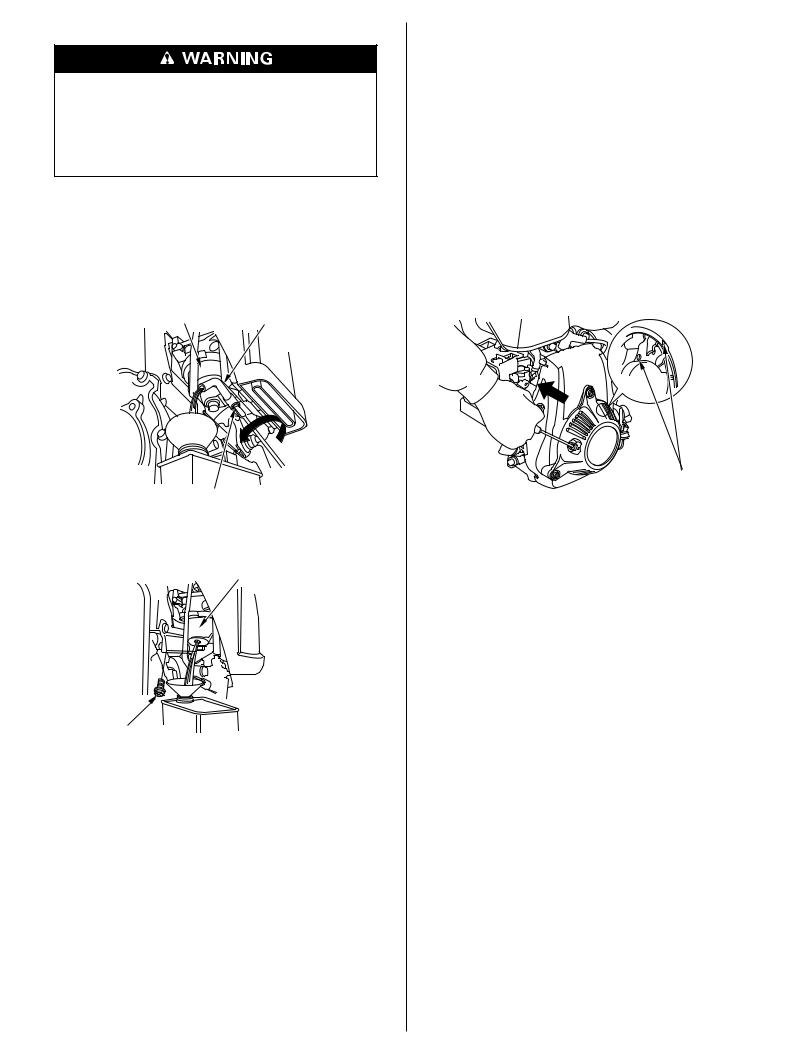
Draining the Fuel Tank and Carburetor
Gasoline is highly flammable and explosive, and you can be burned or seriously injured when handling fuel.
 Stop engine and keep heat, sparks, and flame away.
Stop engine and keep heat, sparks, and flame away.
 Handle fuel only outdoors.
Handle fuel only outdoors.  Wipe up spills immediately.
Wipe up spills immediately.
1.Place an approved gasoline container below the carburetor, and use a funnel to avoid spilling fuel.
2.Drain the fuel tank and carburetor.
CARBURETOR EQUIPPED WITH A DRAIN HOSE AND SCREW: Loosen the carburetor drain screw, then move the fuel valve to the ON position.
DRAIN SCREW
CARBURETOR EQUIPPED WITH DRAIN BOLT:
Remove the carburetor drain bolt, then move the fuel valve to the ON position.
CARBURETOR
DRAIN BOLT
3.After all the fuel has drained into the container, reinstall the drain bolt (carburetor equipped with a drain bolt type only). Tighten the drain bolt or drain screw securely.
Engine Oil
Change the engine oil (see page 8 ).
Engine Cylinder
1.Remove the spark plug (see page 9 ).
2.Pour a tablespoon 5 10 cm (5 10 cc) of clean engine oil into the cylinder.
(5 10 cc) of clean engine oil into the cylinder.
3.Pull the starter grip several times to distribute the oil in the cylinder.
4.Reinstall the spark plug.
5.Pull the starter grip slowly until resistance is felt and the rib on the flywheel aligns with the notch on the fan cover. This will close the valves so moisture cannot enter the engine cylinder. Return the starter grip gently.
Align the rib on the flywheel with the notch on the fan cover.

Storage Precautions
If your engine will be stored with gasoline in the fuel tank and carburetor, it is important to reduce the hazard of gasoline vapor ignition. Select a well-ventilated storage area away from any appliance that operates with a flame, such as a furnace, water heater, or clothes dryer. Also avoid any area with a sparkproducing electric motor, or where power tools are operated.
If possible, avoid storage areas with high humidity, because that promotes rust and corrosion.
Keep the engine level in storage. Tilting can cause fuel or oil leakage.
With the engine and exhaust system cool, cover the engine to keep out dust. A hot engine and exhaust system can ignite or melt some materials. Do not use sheet plastic as a dust cover.
A nonporous cover will trap moisture around the engine, promoting rust and corrosion.
Removal from Storage
Check your engine as described in the BEFORE OPERATION CHECKS section of this manual (see page 3 ).
If the fuel was drained during storage preparation, fill the tank with fresh gasoline. If you keep a container of gasoline for refueling, be sure it contains only fresh gasoline. Gasoline oxidizes and deteriorates over time, causing hard starting.
If the cylinder was coated with oil during storage preparation, the engine will smoke briefly at startup. This is normal.
TRANSPORTING
If the engine has been running, allow it to cool for at least 15 minutes before loading the engine-powered equipment on the transport vehicle. A hot engine and exhaust system can burn you and can ignite some materials.
Keep the engine level when transporting to reduce the possibility of fuel leakage. Turn the fuel valve to the OFF position (see
page 5 ).
TAKING CARE OF UNEXPECTED PROBLEMS
|
ENGINE WILL |
Possible Cause |
Correction |
|
NOT START |
||
|
1. Check control |
Fuel valve OFF. |
Move lever to ON |
|
positions. |
position. |
|
|
Choke open. |
Move lever to |
|
|
CLOSED position |
||
|
unless the engine |
||
|
is warm. |
||
|
Engine switch |
Turn engine switch |
|
|
OFF. |
to ON position. |
|
|
2. Check engine |
Engine oil level |
Fill with the |
|
oil level. |
low |
recommended oil |
|
(Oil Alert stops |
to the proper level |
|
|
engine). |
(p. 8). |
|
|
3. Check fuel. |
Out of fuel. |
Refuel (p. 7). |
|
Bad fuel; engine |
Drain fuel tank and |
|
|
stored without |
carburetor (p. 11). |
|
|
treating or |
Refuel with fresh |
|
|
draining |
gasoline (p. 7). |
|
|
gasoline, or |
||
|
refueled with |
||
|
bad gasoline. |
||
|
4. Remove and |
Spark plug faulty, |
Gap or replace |
|
inspect spark |
fouled, or |
spark plug (p. 9). |
|
plug. |
improperly |
|
|
gapped. |
||
|
Spark plug wet |
Dry and reinstall |
|
|
with fuel |
spark plug. Start |
|
|
(flooded engine). |
engine with |
|
|
throttle lever in |
||
|
MAX. position. |
||
|
5. Take engine to |
Fuel filter |
Replace or repair |
|
an authorized |
restricted, |
faulty components |
|
Honda |
carburetor |
as necessary. |
|
servicing |
malfunction, |
|
|
dealer, or refer |
ignition |
|
|
to shop |
malfunction, |
|
|
manual. |
valves stuck, etc. |
|
ENGINE LACKS |
Possible Cause |
Correction |
|
POWER |
||
|
1. Check air filter. |
Filter element |
Clean or replace |
|
restricted. |
filter element |
|
|
(p. 9). |
||
|
2. Check fuel. |
Bad fuel; engine |
Drain fuel tank and |
|
stored without |
carburetor (p. 11). |
|
|
treating or |
Refuel with fresh |
|
|
draining |
gasoline (P. 7). |
|
|
gasoline, or |
||
|
refueled with |
||
|
bad gasoline. |
||
|
3. Take engine to |
Fuel filter |
Replace or repair |
|
an authorized |
restricted, |
faulty components |
|
Honda |
carburetor |
as necessary. |
|
servicing |
malfunction, |
|
|
dealer, or refer |
ignition |
|
|
to shop |
malfunction, |
|
|
manual. |
valves stuck, etc. |
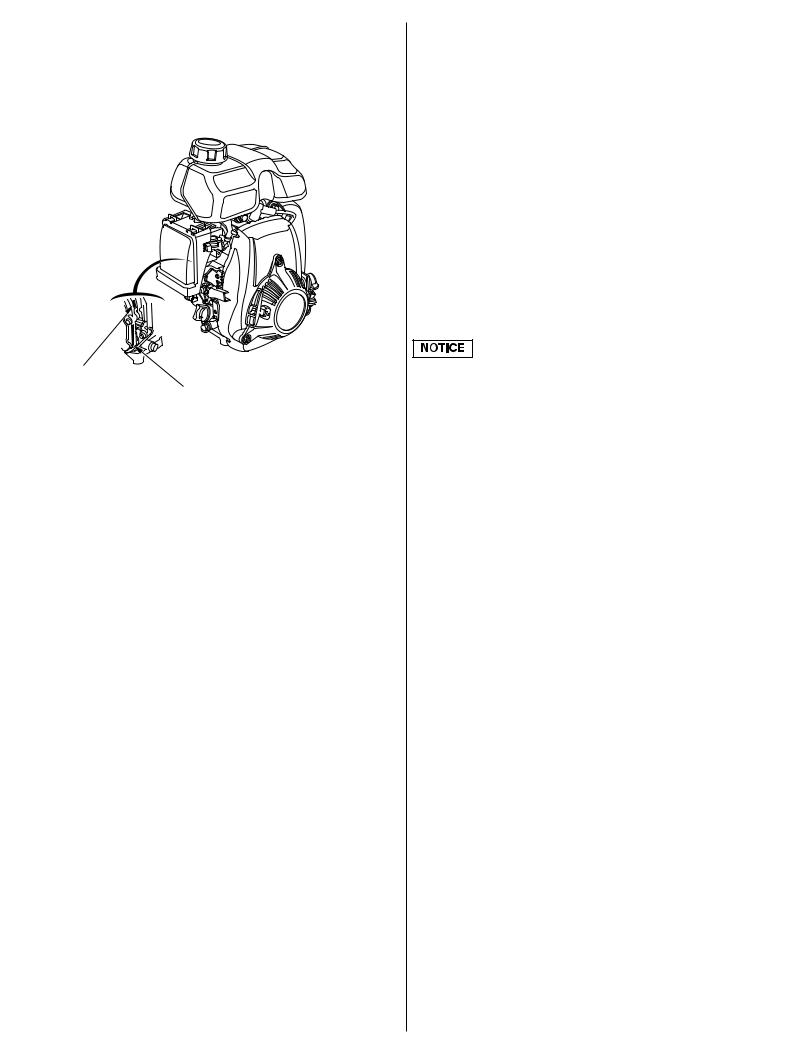
TECHNICAL INFORMATION
Serial Number Location
Record the engine serial number, type and purchase date in the space below. You will need this information when ordering parts and when making technical or warranty inquiries.
ENGINE TYPE
ENGINE SERIAL NUMBER
Engine serial number: __ __ __ __ __ __ __ __ __ __ __
Engine type: ___ ___ ___ ___
Date Purchased: ______ / ______ / ______
Carburetor Modifications for High Altitude Operation
At high altitude, the standard carburetor air-fuel mixture will be too rich. Performance will decrease, and fuel consumption will increase. A very rich mixture will also foul the spark plug and cause hard starting. Operation at an altitude that differs from that at which this engine was certified, for extended periods of time, may increase emissions.
High altitude performance can be improved by specific modifications to the carburetor. If you always operate your engine at altitudes above 1,500 meters (5,000 feet), have your servicing dealer perform this carburetor modification. This engine, when operated at high altitude with the carburetor modifications for high altitude use, will meet each emission standard throughout its useful life.
Even with carburetor modification, engine horsepower will decrease about 3.5% for each 300-meter (1,000-foot) increase in altitude. The effect of altitude on horsepower will be greater than this if no carburetor modification is made.
When the carburetor has been modified for high altitude operation, the air-fuel mixture will be too lean for low altitude use. Operation at altitudes below 1,500 meters (5,000 feet) with a modified carburetor may cause the engine to overheat and result in serious engine damage. For use at low altitudes, have your servicing dealer return the carburetor to original factory specifications.

Emission Control System Information
Source of Emissions
The combustion process produces carbon monoxide, oxides of nitrogen, and hydrocarbons. Control of hydrocarbons and oxides of nitrogen is very important because, under certain conditions, they react to form photochemical smog when subjected to sunlight. Carbon monoxide does not react in the same way, but it is toxic.
Honda utilizes lean carburetor settings and other systems to reduce the emissions of carbon monoxide, oxides of nitrogen, and hydrocarbons. Additionally, Honda fuel systems utilize components and control technologies to reduce evaporative emissions.
The U.S., California Clean Air Acts and Environment Canada
EPA, California and Canadian regulations require all manufacturers to furnish written instructions describing the operation and maintenance of emission control systems.
The following instructions and procedures must be followed in order to keep the emissions from your Honda engine within the emission standards.
Tampering and Altering
Tampering with or altering the emission control system may increase emissions beyond the legal limit. Among those acts that constitute tampering are:
 Removal or alteration of any part of the intake, fuel, or exhaust systems.
Removal or alteration of any part of the intake, fuel, or exhaust systems.
 Altering or defeating the governor linkage or speed-adjusting mechanism to cause the engine to operate outside its design parameters.
Altering or defeating the governor linkage or speed-adjusting mechanism to cause the engine to operate outside its design parameters.
Problems That May Affect Emissions
If you are aware of any of the following symptoms, have your engine inspected and repaired by your servicing dealer.
 Hard starting or stalling after starting.
Hard starting or stalling after starting.
 Rough idle.
Rough idle.
 Misfiring or backfiring under load.
Misfiring or backfiring under load.
 Afterburning (backfiring).
Afterburning (backfiring).
 Black exhaust smoke or high fuel consumption.
Black exhaust smoke or high fuel consumption.
Replacement Parts
The emission control systems on your Honda engine were designed, built, and certified to conform with EPA, California and Canadian emission regulations. We recommend the use of genuine Honda parts whenever you have maintenance done. These original-design replacement parts are manufactured to the same standards as the original parts, so you can be confident of their performance. The use of replacement parts that are not of the original design and quality may impair the effectiveness of your emission control system.
A manufacturer of an aftermarket part assumes the responsibility that the part will not adversely affect emission performance. The manufacturer or rebuilder of the part must certify that use of the part will not result in a failure of the engine to comply with emission regulations.
Maintenance
Follow the maintenance schedule on page 6 . Remember that this schedule is based on the assumption that your machine will be used for its designed purpose. Sustained high-load or hightemperature operation, or use in unusually wet or dusty conditions, will require more frequent service.
Air Index
An Air Index Information hang tag/label is applied to engines certified to an emission durability time period in accordance with the requirements of the California Air Resources Board.
The bar graph is intended to provide you, our customer, the ability to compare the emissions performance of available engines. The lower the Air Index, the less pollution.
The durability description is intended to provide you with information relating to the engine’s emission durability period. The descriptive term indicates the useful life period for the engine’s emission control system. See your Emission Control System Warranty for additional information.
|
Descriptive Term |
Applicable to Emissions Durability Period |
|
|
Moderate |
50 hours [0 80 cm (0 80 cc) inclusive] |
|
|
125 hours [greater than 80 cm |
(80 cc)] |
|
|
Intermediate |
125 hours [0 80 cm (0 80 cc) inclusive] |
|
|
250 hours [greater than 80 cm |
(80 cc)] |
|
|
Extended |
300 hours [0 80 cm (0 80 cc) inclusive] |
|
|
500 hours [greater than 80 cm |
(80 cc)] |
|
|
1,000 hours [225 cm (225 cc) and greater] |
The Air Index Information hang tag/label must remain on the engine until it is sold. Remove the hang tag before operating the engine.

Specifications |
Wiring Diagrams |
|||||||||||||||||||||||||||||||||||||||||||||||||||||
|
(PTO shaft type S) |
Without Oil Alert |
|||||||||||||||||||||||||||||||||||||||||||||||||||||
|
Length × Width × |
225 × 274 × 353 mm |
|||||||||||||||||||||||||||||||||||||||||||||||||||||
|
Height |
(8.9 × 10.8 × 13.9 in) |
|||||||||||||||||||||||||||||||||||||||||||||||||||||
|
Dry mass [weight] |
5.5 kg (12.1 lbs) |
|||||||||||||||||||||||||||||||||||||||||||||||||||||
|
Engine type |
4-stroke, overhead valve, single cylinder |
|||||||||||||||||||||||||||||||||||||||||||||||||||||
|
Displacement |
49.4 cm |
(3.01 cu-in) |
||||||||||||||||||||||||||||||||||||||||||||||||||||
|
[Bore × Stroke] |
[41.8 × 36.0 mm (1.65 × 1.42 in)] |
|||||||||||||||||||||||||||||||||||||||||||||||||||||
|
Net power |
1.6 kW (2.2 PS, 2.1 bhp) at 7,000 rpm |
|||||||||||||||||||||||||||||||||||||||||||||||||||||
|
(in accordance with SAE J1349 ) |
||||||||||||||||||||||||||||||||||||||||||||||||||||||
|
Max. Net torque |
2.7 N·m (0.28 kgf·m, 2.0 lbf·ft) at |
|||||||||||||||||||||||||||||||||||||||||||||||||||||
|
(in accordance with SAE J1349 ) |
4,500 rpm |
|||||||||||||||||||||||||||||||||||||||||||||||||||||
|
Fuel tank capacity |
0.77 (0.203 US gal , 0.169 Imp gal) |
|||||||||||||||||||||||||||||||||||||||||||||||||||||
|
Engine oil capacity |
0.25 (0.26 US qt , 0.22 Imp qt) |
|||||||||||||||||||||||||||||||||||||||||||||||||||||
|
Cooling system |
Forced air |
|||||||||||||||||||||||||||||||||||||||||||||||||||||
|
Ignition system |
Transistor magneto |
|||||||||||||||||||||||||||||||||||||||||||||||||||||
|
PTO shaft rotation |
Counterclockwise |
|||||||||||||||||||||||||||||||||||||||||||||||||||||
|
The power rating of the engine indicated in this document is the |
||||||||||||||||||||||||||||||||||||||||||||||||||||||
|
net power output tested on a production engine for the engine |
With Oil Alert |
|||||||||||||||||||||||||||||||||||||||||||||||||||||
|
model and measured in accordance with SAE J1349 at 7,000 |
||||||||||||||||||||||||||||||||||||||||||||||||||||||
|
rpm (Net Power) and at 4,500 rpm (Max. Net Torque). Mass |
||||||||||||||||||||||||||||||||||||||||||||||||||||||
|
production engines may vary from this value. |
||||||||||||||||||||||||||||||||||||||||||||||||||||||
|
Actual power output for the engine installed in the final machine |
||||||||||||||||||||||||||||||||||||||||||||||||||||||
|
will vary depending on numerous factors, including the |
||||||||||||||||||||||||||||||||||||||||||||||||||||||
|
operating speed of the engine in application, environmental |
||||||||||||||||||||||||||||||||||||||||||||||||||||||
|
conditions, maintenance, and other variables. |
||||||||||||||||||||||||||||||||||||||||||||||||||||||
Tuneup Specifications |
||||||||||||||||||||||||||||||||||||||||||||||||||||||
|
ITEM |
SPECIFICATION |
MAINTENANCE |
||||||||||||||||||||||||||||||||||||||||||||||||||||
|
Spark plug gap |
0.60 0.70 mm |
Refer to page 9 |
||||||||||||||||||||||||||||||||||||||||||||||||||||
|
(0.024 0.028 in) |
||||||||||||||||||||||||||||||||||||||||||||||||||||||
|
Idle speed |
2,500 ± 200 rpm |
See your |
||||||||||||||||||||||||||||||||||||||||||||||||||||
|
Valve clearance |
IN: 0.08 ± 0.02 mm |
authorized |
||||||||||||||||||||||||||||||||||||||||||||||||||||
|
(cold) |
EX: 0.11 ± 0.02 mm |
Honda dealer |
||||||||||||||||||||||||||||||||||||||||||||||||||||
|
Other |
No other adjustments needed. |
|||||||||||||||||||||||||||||||||||||||||||||||||||||
|
specifications |
||||||||||||||||||||||||||||||||||||||||||||||||||||||
|
Bl |
Black |
Br |
Brown |
(A) OIL LEVEL SWITCH |
||||||||||||||||||||||||||||||||||||||||||||||||||
Quick Reference Information |
Y |
Yellow |
O |
Orange |
(B) OIL ALERT UNIT |
|||||||||||||||||||||||||||||||||||||||||||||||||
|
Bu |
Blue |
Lb |
Light blue |
(C) ENGINE SWITCH |
||||||||||||||||||||||||||||||||||||||||||||||||||
|
Fuel |
Unleaded gasoline (Refer to page 7) |
G |
Green |
Lg |
Light green |
(D) IGNITION COIL |
||||||||||||||||||||||||||||||||||||||||||||||||
|
U.S. |
Pump octane rating 86 or higher |
R |
Red |
P |
Pink |
(E) SPARK PLUG |
||||||||||||||||||||||||||||||||||||||||||||||||
|
Except |
Research octane rating 91 or higher |
W |
White |
Gr |
Gray |
|||||||||||||||||||||||||||||||||||||||||||||||||
|
U.S. |
Pump octane rating 86 or higher |
|||||||||||||||||||||||||||||||||||||||||||||||||||||
|
Engine oil |
SAE 10W-30, API SJ or later, for general use. |
|||||||||||||||||||||||||||||||||||||||||||||||||||||
|
Refer to page 7. |
||||||||||||||||||||||||||||||||||||||||||||||||||||||
|
Spark plug |
CR5HSB (NGK) |
|||||||||||||||||||||||||||||||||||||||||||||||||||||
|
U16FSR-UB (DENSO) |
||||||||||||||||||||||||||||||||||||||||||||||||||||||
|
Maintenance |
Before each use: |
|||||||||||||||||||||||||||||||||||||||||||||||||||||
|
Check engine oil level. Refer to page 8. |
||||||||||||||||||||||||||||||||||||||||||||||||||||||
|
Check air filter. Refer to page 9. |
||||||||||||||||||||||||||||||||||||||||||||||||||||||
|
First 10 hours: |
||||||||||||||||||||||||||||||||||||||||||||||||||||||
|
Change engine oil. Refer to page 8. |
||||||||||||||||||||||||||||||||||||||||||||||||||||||
|
Subsequent: |
||||||||||||||||||||||||||||||||||||||||||||||||||||||
|
Refer to the maintenance schedule on page 7. |
||||||||||||||||||||||||||||||||||||||||||||||||||||||
 Loading…
Loading…
 Loading…
Loading…
INTRODUCTION
CONTENTS
SAFETY MESSAGES
ENGLISH
FR
ANÇ
A
IS
ESPAÑOL
ENGLISH
DAMAGE PREVENTION MESSAGES
OWNER’S MANUAL
MANUEL DE L’UTILISATEUR
MANUAL DEL PROPIETARIO
GXH50
1
Thank you for purchasing a Honda engine. We want to help you to
get the best results from your new engine and to operate it safely.
This manual contains information on how to do that; please read it
carefully before operating the engine. If a problem should arise, or
if you have any questions about your engine, consult an
authorized Honda servicing dealer.
This manual should be considered a permanent part of the engine
and should remain with the engine if resold.
The engine exhaust from this product
contains chemicals known to the State of
California to cause cancer, birth defects
or other reproductive harm.
All information in this publication is based on the latest product
information available at the time of printing. Honda Motor Co., Ltd.
reserves the right to make changes at any time without notice and
without incurring any obligation. No part of this publication may
be reproduced without written permission.
The purpose of these messages is to help prevent damage to your
engine, other property, or the environment.
Your engine or other property can be damaged if you
don’t follow instructions.
This word means:
You will also see other important messages that are preceded by
the word NOTICE.
Each message tells you what the hazard is, what can happen, and
what you can do to avoid or reduce injury.
You CAN be HURT if you don’t follow
instructions.
You CAN be KILLED or SERIOUSLY
HURT if you don’t follow instructions.
You WILL be KILLED or SERIOUSLY
HURT if you don’t follow instructions.
These signal words mean:
A safety message alerts you to potential hazards that could hurt
you or others. Each safety message is preceded by a safety alert
symbol
and one of three words, DANGER, WARNING, or
CAUTION.
Your safety and the safety of others are very important. We have
provided important safety messages in this manual and on the
engine. Please read these messages carefully.
Review the instructions provided with the equipment powered by
this engine for any additional information regarding engine
startup, shutdown, operation, adjustments or any special
maintenance instructions.
United States, Puerto Rico, and U.S. Virgin Islands:
We suggest you read the warranty policy to fully understand its
coverage and your responsibilities of ownership. The warranty
policy is a separate document that should have been given to you
by your dealer.
……………………
SPARK PLUG
.9
………….
SPARK ARRESTER
.10
HELPFUL TIPS &
………………….
SUGGESTIONS
.10
…
STORING YOUR ENGINE .10
…………….
TRANSPORTING
.12
TAKING CARE OF
….
UNEXPECTED PROBLEMS
.12
..
TECHNICAL INFORMATION .13
…..
Serial Number Location
.13
Carburetor Modifications for
…..
High Altitude Operation
.13
Emission Control System
…………………….
Information
.14
…………………………
Air Index
.14
…………………
Specifications
.15
……..
Tuneup Specifications
.15
Quick Reference
…………………….
Information
.15
…………….
Wiring Diagrams
.15
.
CONSUMER INFORMATION .16
Distributor/Dealer Locator
…………………….
Information
.16
Customer Service
…………………….
Information
.16
2007 Honda Motor Co., Ltd.
All Rights Reserved
…………………..
INTRODUCTION
.1
…………….
SAFETY MESSAGES
.1
……….
SAFETY INFORMATION
.2
COMPONENT & CONTROL
…………………………..
LOCATION
.2
…………………………..
FEATURES
.2
BEFORE OPERATION
………………………………
CHECKS
.3
…………………………
OPERATION
.3
SAFE OPERATING
…………………
PRECAUTIONS
.3
……
STARTING THE ENGINE
.3
…..
SETTING ENGINE SPEED
.4
……
STOPPING THE ENGINE
.5
…..
SERVICING YOUR ENGINE
.6
THE IMPORTANCE OF
………………..
MAINTENANCE
.6
……
MAINTENANCE SAFETY
.6
…….
SAFETY PRECAUTIONS
.6
MAINTENANCE
……………………….
SCHEDULE
.6
………………………
REFUELING
.7
………………………
ENGINE OIL
.7
…………
Recommended Oil
.7
………………
Oil Level Check
.8
…………………….
Oil Change
.8
……………………
AIR CLEANER
.9
……………………..
Inspection
.9
……………………….
Cleaning
.9
37Z4C603
00X37-Z4C-6030
GXH50U
07/06/01 17:15:56 32Z4C600_001












